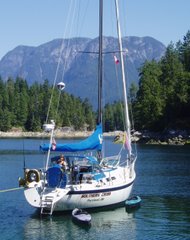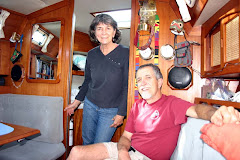
The next morning, we motored toward the bar, keeping a close eye on the depthfinder. As it went under 10 feet, we got a little bit nervous, and as we saw a set of steep swells form up behind us, I gulped! But we made it through OK, and were soon in the estuary - the first river since leaving Portland back in July.

There are several other cruisers here, and a local sportfishing guide named Norm Goldie with information and advice for new arrivals. There's also a new marina, but we now prefer to anchor out whenever possible to maximize the breeze. The money we save on moorage means more dining out! And the estuary is a colorful location, with a view of the local shrimp fleet, and plenty of birdlife.


But its hot here, probably the hottest place we've been so far.

Ashore, we found San Blas to be a delightfully laid back little town, although popular with gringos and Mexican tourists. We ambled our way from bakery to fish market to produce stalls, stopping for a licuado at the mercado.


San Blas is a historic town, and was once the center of Spanish colonial activities on this section of the coast. The older roads are hand-laid stone.

We hiked up to the ruined fortress for a view of the town, the estuary, and the sea.


Behind the fort is a ruined church.

This church is said to have inspired Longfellow's poem, the Bells of San Blas:
What say the Bells of San Blas
To the ships that southward pass
From the harbor of Mazatlan?
To them it is nothing more
Than the sound of surf on the shore,--
Nothing more to master or man.
But to me, a dreamer of dreams,
To whom what is and what seems
Are often one and the same,--
The Bells of San Blas to me
Have a strange, wild melody,
And are something more than a name.
The bells are gone now. We'll be here for a few more days while a norther blows hard offshore.








































